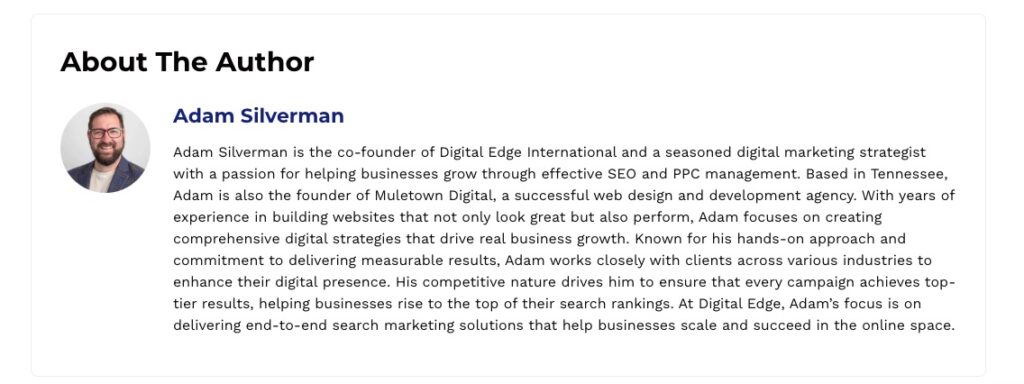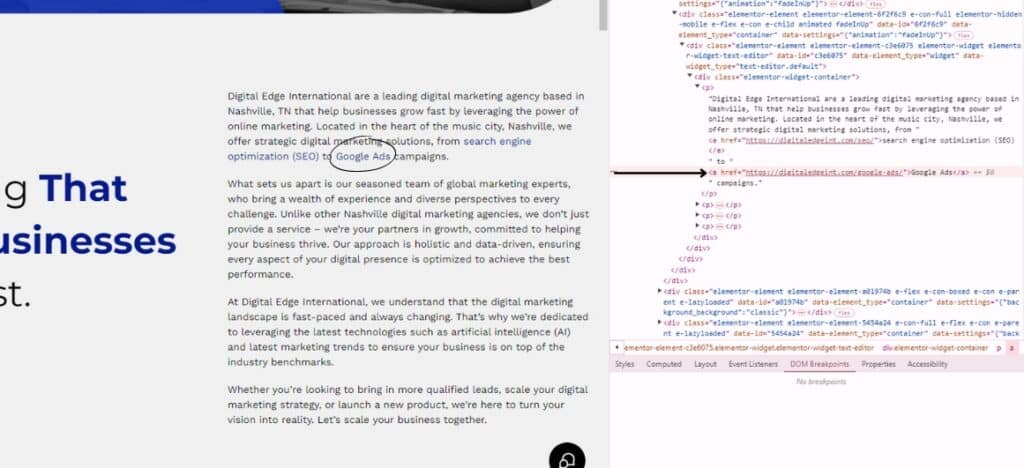Content forms a fundamental part of your overall search engine optimization. While traditionally SEO has been strongly focused around on-page, off-page and technical elements, high quality content has become an increasingly important factor to consider, both for user experience and in targeting search engine rankings.
Writing great content requires more than just putting words on a page, especially when it forms part of your SEO strategy. SEO content requires careful planning, research and intent, along with subject knowledge, and the ability to provide significant value to your website visitors. In this guide, we’ll cover a step-by-step approach to producing content for SEO, taking you through everything you need to consider in planning, producing and publishing content on your own website, plus helpful tips and resources to get you on your way.
Need help with SEO copywriting? For SEO focused content marketing services, contact our team at Digital Edge International today.
What is SEO Content?
SEO content, in its simplest form, refers to any content created to help a website rank in search engines like Google. While website content in general is designed to provide relevant information to a user, SEO content also focuses on keyword targeting, structure and content value to address particular search queries that your target audience may be looking for. By optimizing content for both users and search engines, businesses or website owners can enhance visibility, demonstrate expertise and authority and increase engagement.
Why is Content Important for Search Engine Optimization?
Content is the foundation of effective SEO, forming the basis of what search engines are looking for when they populate the search engine results pages (SERPs). The core aim of Google is to provide the most relevant and helpful resources to match a user’s query. To determine which sites meet these criteria, search engines employ comprehensive algorithms to discover, analyze and index new content. We can employ SEO techniques such as on-page optimization, link building and technical support to help Google find and interpret website pages but ultimately the quality of your content is what counts.
High quality content answers users’ questions, addresses their needs, and aligns with their search intent. Without well crafted, informative, and relevant content, even the best SEO strategies will struggle to attract or retain organic traffic.
The Four Pillars of SEO
A comprehensive SEO strategy covers four essential areas – on-page, off-page, content and technical SEO. Each of these four pillars work together to cohesively optimize your web pages for search rankings. SEO content is not only a fundamental element on its own, it also actively supports other areas of your SEO campaign. Content provides an in-depth way to naturally incorporate your target keywords and increase relevance. It allows you to speak directly to your potential customers, increasing engagement and boosting conversions. Valuable content also plays a key role in establishing trust and authority which are key factors in search engine optimization. Informative content that addresses a topic comprehensively can attract backlinks from other sites, supporting your off-page SEO. In essence, content is the main factor through which SEO objectives are achieved, connecting technical strategies with user-focused outcomes.
Types of SEO Content
SEO content encompasses various content types, including blog posts, articles, product pages, guides, and multimedia, each tailored to meet different user needs. When we talk about SEO content, we are generally referring to any significant information that is added to your website.
Some common examples of SEO content include:
Website Copy
Website copy includes your home page, about page, service pages and any other key pages that form the body of your website. The number and type of these pages can vary greatly depending on your business or niche – some websites will need only a handful of basic pages to rank effectively, others may involve a significant volume of information requiring careful planning and structure.
Blog Content
For business websites, blogs often play a supporting content role, increasing the topical relevance of your site for your keyword focus. For other websites, blogs may be your primary content source, forming the basis of your content marketing strategy. Blogs can cover almost any form of content creation you like including short form and long form content, lists, how-to guides, answers to common questions and more.
Long Form Articles and Guides
While long form articles may fall under the umbrella of a blog post, they are worth mentioning separately for their SEO value. Long form content allows you to deep dive into a topic, providing a comprehensive, in-depth resource. This in turn creates a valuable piece of content on your site that demonstrates your experience, expertise and authority in your area, provides helpful information for users, attracts shares and backlinks, and meets the requirements of Google search algorithms – all essential factors in your SEO success.
Landing Pages
Landing pages are specifically designed to engage customers quickly and to effectively generate conversions. Landing page content must therefore be written in a way that grabs attention, sells your product or service succinctly and guides users towards a desired outcome.
Category and Product Pages
Product and category pages on eCommerce sites have unique content requirements due to the nature and volume of information they present. Like landing pages, this content is designed to convert while also being optimized for Google searches. Product pages must clearly communicate each item’s features, specifications, and benefits, helping customers make informed purchasing decisions. Category pages work to organize products effectively, boosting rankings for broader, high-level keywords.
Media
When we think of content, we often think of copywriting but media based information is also crucial to consider. Multimedia content includes images, infographics and diagrams, video and audio and tools such as quizzes and calculators. Incorporating media into your content strategy helps to support written copy, while also being a valuable resource on its own.
Creating Content for SEO
When you create content for your website, there are some core components that need to be considered. Below we’ve covered a few tips to get you started on the right path.
Keyword Research
Like any good SEO strategy, keyword research is the underlying factor in everything you do. You’ve likely already identified the high-level keyword themes for your website but aligning these with your content strategy requires a little more work.
There are many SEO tools available to assist with keyword research for content including Google’s own Keyword Planner, comprehensive SEO programs such as Ahrefs and Semrush and free offerings such as Ubersuggest and AnswerThePublic.

Short Tail Keywords
Short tail keywords, also referred to as focus keywords, seed keywords or head terms are usually made up of 1-2 words and form the primary keyword themes of your website. They refer to your broad overall topics or niche, generally have higher search volume and are the more competitive keywords to target. If you are writing content for one of the main pages in your site such as a service page or product page, you’ll probably be looking to target your primary keywords here.
Long Tail Keywords
Long tail keywords are more specific and usually target a more detailed aspect of your niche. Long tail keywords are commonly made up of 3-5 words and have a more refined intent behind them. These keywords are useful when writing blogs, articles and guides as they allow you to cover one aspect of your market in more depth. Long tail keywords also allow you to write multiple articles around a single seed keyword, supporting your overall keyword targeting and optimization.
Search Intent
When conducting keyword research, it’s also important to consider the user intent behind a search query. Understanding not only what your target audience are searching, but also why they are looking for it can help you to produce content that effectively meets their needs.
There are four recognized types of user intent:
Navigational: Users with navigational intent are searching for a specific website or page, often by typing the brand or site name directly into the search bar to reach a particular destination quickly.
Informational: Users with informational intent are seeking answers, advice, or insights on a topic, often through how-to guides, articles, or general information on a subject of interest.
Commercial: Users with commercial intent are researching products or services before making a purchase, comparing options, reading reviews, and looking at recommendations to make an informed decision.
Transactional: Transactional intent signals a user’s readiness to make a purchase or complete an action, they are searching for a particular product or service to engage with.
Structuring Content
Before you begin writing, it is important to decide what your content needs to cover and how the information should be presented. A well-planned structure not only makes the content more readable and engaging for users but also helps search engines interpret and rank your page effectively.
Start by outlining key sections and identifying the purpose of each part, ensuring the content flows logically and covers all necessary information. Establishing the structure first also helps in the writing process because it allows you to simply fill in the gaps for each section and avoids unnecessary repetition of information.
Headings
Use headings and subheadings to divide your content into easily digestible sections. Headings guide readers through the material and signal to search engines which topics are covered. Your H1 should indicate the main topic of your page including your target keyword, while subheadings (H2-H6) define the different subsections and can incorporate related or secondary keywords.
Writing Content
When it comes to writing, you should aim to create content that both aligns with your target keywords and provides relevant, unique and valuable information for your readers. Consider your target market – where are they coming from and what problem do they have that you may be able to help them solve?
Language
Use appropriate language for the audience you are speaking to. Avoid overly technical language and industry jargon, instead present your information in a way that is clear, concise, easy to understand and uses the same words that your readers are searching for.
Relevant Keywords
Incorporate relevant keywords naturally throughout your content. Include the primary and secondary keywords identified through your keyword research and consider the way they align with user intent. Strategically placing these keywords in headings, introductions, and throughout the text can improve your page’s relevance and ranking.
Keyword Density
Maintain an optimal keyword density to avoid keyword stuffing, which can negatively impact rankings. Aim to use keywords in a way that reads naturally, supporting the flow of information without overuse.
Supporting Evidence
Including supporting evidence in your content such as references, quotes, statistics, and case studies can significantly enhance its trustworthiness and authority. By backing up claims with credible sources from industry experts, published studies, or other reputable websites in your field, you show readers (and search engines) that your information is well researched and reliable, reinforcing quality and accuracy.
Multimedia
Integrating media such as infographics, images, video into your content has multiple benefits. Images can help to break up large blocks of content, helping users navigate the information more easily, and provide visual interest. Infographics help to demonstrate concepts in visual form and are great shareable resources to increase your reach. Video and audio appeal to users who may prefer a non-written form of information and can also increase engagement and time spent on your pages. Incorporating multimedia into your content adds to the depth and richness of your information, allowing you to create more comprehensive resources.
Google Content Guidelines
As we discussed earlier, Google’s primary aim when analyzing content is to ensure that users receive accurate, helpful and reliable information in search results, which means the most effective way to rank well is to create content that aligns with this goal. While Google will never tell you exactly how their algorithms work or how to actively achieve higher rankings, they have provided some guidelines designed to help you evaluate the quality of your content based on what they are looking for. As well as enabling you to assess the strength of your current content, these guides can also be a valuable resource in helping you produce new SEO friendly content for your site.
Helpful Content
The Google Helpful Content updates were first introduced in August 2022 and aim to prioritize content created primarily to benefit users rather than to manipulate search rankings. Google have created documentation to go along with this to “help creators evaluate if they’re producing such content“. Key recommendations include:
- Prioritize People-First Content: Develop content that addresses the needs and interests of your target audience, ensuring it provides genuine value and satisfies user intent.
- Demonstrate Experience and Expertise: Showcase your knowledge and firsthand experience on the subject matter to establish credibility and trustworthiness.
- Avoid Search Engine First Content: Refrain from creating content solely to attract search engine traffic, instead focus on delivering meaningful information that benefits users.
- Maintain High-Quality Standards: Ensure your content is well researched, accurate, and free from errors, providing a comprehensive and satisfying user experience.
E-E-A-T
The E-E-A-T framework highlights four key factors that Google uses to evaluate content quality:
- Experience: Does the author have firsthand knowledge or experience of the topic?
- Expertise: Does the author possess a deep and knowledgeable understanding of the subject matter?
- Authoritativeness: Is the author or source considered credible within their field or industry?
- Trustworthiness: Is the content reliable, accurate, and free from misleading information?
Integrating these qualities into your content helps establish it as a credible resource, increases reader trust, and signals to Google that your site is a reliable source.
Publishing Content
Optimizing content during the publishing stage is essential for supporting SEO and improving visibility. Here are some additional strategies to implement when you publish content to your website:
Author Bio
Including an author bio with relevant credentials can boost the content’s authority and trustworthiness, helping to support E-E-A-T factors and demonstrating the author’s expertise in their field.

Internal Linking
Adding internal links to and from your new piece of content creates connections across your site, helping search engines better understand and navigate the relationships between pages. Linking to the higher value pages in your site passes on “link juice” signifying their importance in your overall site structure, while creating a network of links between blog posts, pages and articles helps search engines to crawl and index your content.

Meta
Crafting an optimized meta title and description for every piece of content you create is vital for supporting your SEO efforts. The meta title should reflect your main topic, including your primary keyword, while the description should summarize the content and encourage the reader to click through.

Site Structure
Consider how your content fits into your site’s structure. Grouping relevant content together can increase its overall strength, connecting related topics and allowing for clear and logical linking between pages. Clear site structure also helps search engines to better understand and navigate your content and increases usability for your audience.
INSERT IMAGE OF CONTENT SILO STRUCTURE
Managing SEO Content
To maintain a strong SEO presence, it’s essential to adopt ongoing strategies for managing your website’s content. Regularly reviewing and optimizing content not only keeps it relevant for users but also ensures search engines continue to view your site as active and valuable.
Duplicate Content
Duplicate content can significantly impact your search engine rankings. Presenting the same information across more than one page can confuse search engines into not knowing which page is the best resource and can often lead to all pages ranking lower (or not at all). Ensure that each piece of content on your site is unique and has a specific focus and purpose. Where duplication is unavoidable, such as for similar products, using canonical tags or consolidating information on one primary page can help to avoid dilution of search rankings.
Reviewing Old Content
Google not only considers the value of each individual piece of content, they also assess the overall quality of content across your website. Regularly reviewing your existing content can help you to identify pages that are underperforming or out of date. In some cases, updating facts, revising keywords, and refreshing outdated references and links can extend the life and relevance of older pages, or where older content no longer adds any value, removing it entirely can help to increase to overall strength and SEO performance of your site.
Fresh Content
Continually publishing fresh, relevant content is essential for ongoing SEO success. Regularly adding new articles, blogs, or updates shows search engines that your site is active, up to date and committed to providing valuable information. Fresh content also gives you more opportunities to target different keywords, respond to evolving trends, and attract more traffic.
Ready to Enhance Your SEO Content?
Creating effective SEO content is a multi-faceted process that combines strategic planning, high-quality writing, and ongoing optimization techniques. By following the guidelines and tips in this guide, you can create content that boosts visibility, engages readers, and supports your overall SEO strategy.
If you’re looking to take your SEO content to the next level or need expert guidance on developing a winning content strategy, reach out to our team at Digital Edge International today and let us help you achieve first page rankings for your business.



